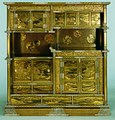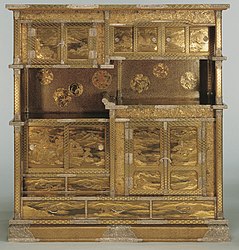File:Khalili Collection Japanese Meiji Art L122.jpg

Original file (2,394 × 2,500 pixels, file size: 2.22 MB, MIME type: image/jpeg)
Captions
Captions
Contents
Summary
Object
| Harui Komin: Cabinet
|
|||||||||||||||||||||
|---|---|---|---|---|---|---|---|---|---|---|---|---|---|---|---|---|---|---|---|---|---|
| Artist |
|
||||||||||||||||||||
| Title |
Cabinet |
||||||||||||||||||||
| Object type |
cabinet |
||||||||||||||||||||
| Description |
English: A cabinet comprising shelves, drawers, and cupboards with silver fittings, presented by Crown Prince Hirohito of Japan to the Prince of Wales during the former's visit to England.
The cabinet consists of two cupboards in diagonally opposite corners, each with a pair of doors hinged at the sides and with a central opening. To one side of each cupboard additional cupboards with sliding doors, with drawers below, with staggered shelves formed by the tops of the cupboards. The fronts of the cupboards, sliding doors, and drawer-fronts decorated with landscape views in the traditional style. The insides of the doors of the smaller, upper cupboard portray a pair of confronting ho-o birds among paulownia-trees and stylized clouds. The inside of the doors of the bottom cupboard depict shishi throwing themselves down a waterfall in a rocky terrain, around which peonies grow. This larger cupboard also contains a drawer. The larger areas surrounding the doors and sliding panels embellished with a profusion of flowers in gold and silver takamakie, the thinner borders composed of the hanabishi pattern inlaid in gold foil. The base covered with a linked key-fret design. The rear panel facing the viewer, the back proper, the top and sides of the cabinet all decorated with floral roundels, most of which also contain a bird, insect, or animal appropriate to or seasonal with the plant, such as the squirrel and vine or the hare and horsetail, all on various gold-sprinkled grounds. The lacquer decoration carried out in gold and silver hiramakie and takamakie, red and black lacquer, with kirikane and inlays of shell on a black lacquer ground sprinkled with gold. The interiors of the cupboards and drawers all of nashiji. The English translation of a letter from Baron Sumitomo dated 12 April 1922, recently discovered by chance in the archives of the Far Eastern Department of the Victoria and Albert Museum, provides us with the background to the manufacture of this most resplendent example of the classical revival style of the late Meiji and Taisho periods. The text is given here without alteration: Kyoto Association of Lacquer Craftsmen, Kyoshikki: Kindai no bito dento shiryohen, s.v. 'Harui Komin', gives a slightly different account of the artist's career, recording that he was a pupil of the fifth generation of Yamamoto Rihei and that he worked for Ikeda Seisuke in the Meiji period. In 1912, after the closure of Ikeda's business, he moved to Kyoto and later, for health reasons, to Suma. Nothing is known of the collaborations listed, with the exception of Miyake Gogyo (1864-1919), a minor Kyoto painter who exhibited from 1907. In 1921 the Crown Prince of Japan, Hirohito, visited England. To symbolize the significance of the trip and to cement peace and good will, this lacquer cabinet was presented to the Prince of Wales, later for a brief period King Edward VIII. The cabinet was apparently commissioned by Baron Sumitomo, presented by him to the Emperor, and subsequently selected as an appropriate gift for the royal visit. |
||||||||||||||||||||
| Date |
between circa 1904 and circa 1911 date QS:P,+1950-00-00T00:00:00Z/7,P1319,+1904-00-00T00:00:00Z/9,P1326,+1911-00-00T00:00:00Z/9,P1480,Q5727902 |
||||||||||||||||||||
| Collection |
institution QS:P195,Q63160499 |
||||||||||||||||||||
| Accession number | |||||||||||||||||||||
| Place of creation |
Japan |
||||||||||||||||||||
| References |
https://www.khalilicollections.org/collections/japanese-art-of-the-meiji-period/khalili-collections-japanese-art-of-the-meiji-period-cabinet-l122/ (English) |
||||||||||||||||||||
Photograph
| Author | Khalili Collections | ||
| Permission (Reusing this file) |
|
Licensing
- You are free:
- to share – to copy, distribute and transmit the work
- to remix – to adapt the work
- Under the following conditions:
- attribution – You must give appropriate credit, provide a link to the license, and indicate if changes were made. You may do so in any reasonable manner, but not in any way that suggests the licensor endorses you or your use.
- share alike – If you remix, transform, or build upon the material, you must distribute your contributions under the same or compatible license as the original.
File history
Click on a date/time to view the file as it appeared at that time.
| Date/Time | Thumbnail | Dimensions | User | Comment | |
|---|---|---|---|---|---|
| current | 18:07, 13 November 2020 |  | 2,394 × 2,500 (2.22 MB) | MartinPoulter (talk | contribs) | Opened and saved in IrfanView to fix colours |
| 15:35, 12 November 2020 |  | 2,394 × 2,500 (2.26 MB) | MartinPoulter (talk | contribs) | pattypan 20.04 |
You cannot overwrite this file.
File usage on Commons
The following page uses this file:
File usage on other wikis
The following other wikis use this file:
- Usage on www.wikidata.org
Metadata
This file contains additional information such as Exif metadata which may have been added by the digital camera, scanner, or software program used to create or digitize it. If the file has been modified from its original state, some details such as the timestamp may not fully reflect those of the original file. The timestamp is only as accurate as the clock in the camera, and it may be completely wrong.
| Image title |
|
|---|---|
| Copyright holder |
|
| Width | 2,394 px |
| Height | 2,500 px |
| Compression scheme | Uncompressed |
| Pixel composition | Separated (Probably CMYK) |
| Orientation | Normal |
| Number of components | 4 |
| Horizontal resolution | 254 dpc |
| Vertical resolution | 254 dpc |
| Data arrangement | chunky format |
| Software used | Adobe Photoshop CS6 (Macintosh) |
| File change date and time | 16:49, 11 December 2018 |
| Color space | Uncalibrated |
| Unique ID of original document | adobe:docid:photoshop:0497d6a7-b64d-11d8-9722-da647cc13c31 |
| Date and time of digitizing | 16:42, 20 November 2018 |
| Date metadata was last modified | 16:49, 11 December 2018 |
| Copyright status | Copyrighted |
- Items with VRTS permission confirmed
- Artworks with Wikidata item
- Artworks with accession number from Wikidata
- Artworks with known accession number
- Artworks with Wikidata item missing genre
- Artworks digital representation of unknown type of work
- CC-BY-SA-4.0
- Uploaded with pattypan
- Files with no machine-readable source

